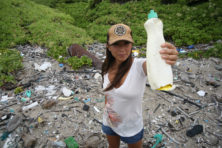Study Shows What Wisconsin Can Do With Wasted Plastic
- Share
- Tweet
- Pin
- Share
Wisconsin trashed $64 million of plastic in 2009, according to a recent Department of Natural Resources report.
“There’s a lot of material out there that could be put to better use, and if it were put to better use it would help Wisconsin economy and help job growth,” said Brad Wolbert, Department of Natural Resources section chief. “The question is how do you do that?”
On Feb. 5, the DNR released a report, Wisconsin Plastic Recycling Study, that outlines how much plastic we waste in Wisconsin, how we can avoid it and how increasing recycling will create more jobs.
Mike Rekitzke, president of N.E.W. Plastics Corp. in Luxemburg, Wisc., said access to more recycled plastic would help his business.
“It’s a tight market,” Rekitzke said. “Supply and demand plays a huge part in that. If there was more recycled plastic available it would help the cost situation.”
N.E.W. Plastics Corporation makes food and beverage containers out of virgin plastic and lumber out of recycled plastic. It recycles plastic it uses for the food and beverage containers, and gets post-consumer recycled plastic from other distributors.
More access to recycled plastic would mean more supply, and more supply means a lower price.
“Any time we can reduce the cost of raw materials going into our product [it] makes us more competitive,” Rekitzke said.
N.E.W. Plastics Corp. was just one of the businesses interviewed in the Wisconsin Plastic Recycling Study. Other companies also said they’d be more able to grow or compete with more recycled plastic available.
“It was really eye opening to me that there’s this real need for material out there, and meanwhile we’re just wasting some of this material,” Wolbert said.
Material isn’t wasted just because some people toss their recyclables. Lower-grade plastics, like number 7, are rarely accepted at recycling centers because they’re difficult to break down and sell.
Number 7 is made of many different types of plastic. In order to recycle it, you have to separate the plastics and break them down individually.
Getting more plastic recycled means using less low-grade plastic in manufacturing and packaging, said Jeff Johnson, owner of Going Garbage.
“When a consumer buys a product that’s contained in plastic, like packaging, it can commonly have several different types of plastic in its assembly,” Johnson said. “A bottle could be a different type of plastic than the cap. That complicates plastic handling.”
Going Garbage only accepts number 1 and 2 plastics. Johnson takes the material to a sorting plant in Outagamie County and, therefore, can only collect the plastics they’ll accept.
“Not everybody handles all plastic, and the fact that there are these different kinds of plastics contributes to slowing down the system of recycling,” Johnson said.
Consumer education is an important part of getting more plastic in the recycling bin. Johnson said simplifying recycling by accepting more material and sending a simple, consistent message on what can and can’t be recycled would help.
Explaining how much plastic ends up in the landfill would help convince people to recycle, too.
“There are other places plastic can go besides the landfill, and unfortunately if it goes in the landfill it has a long life,” Johnson said. “It’s not one of those things that breaks down.”

